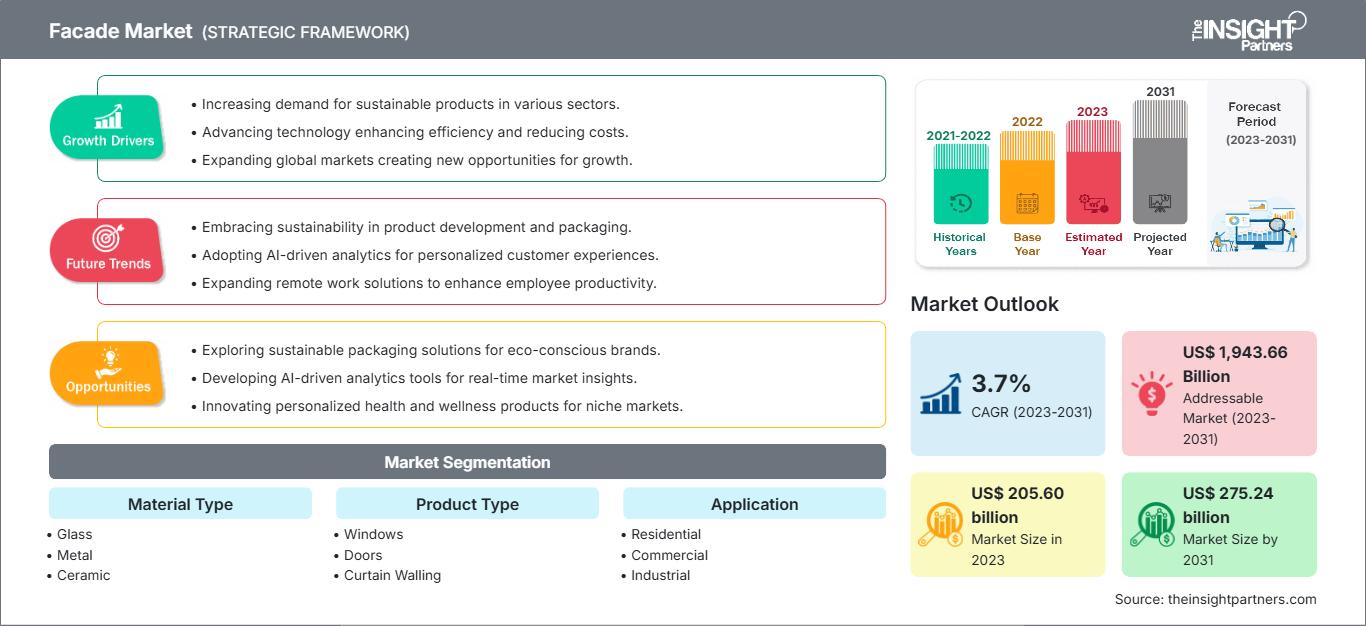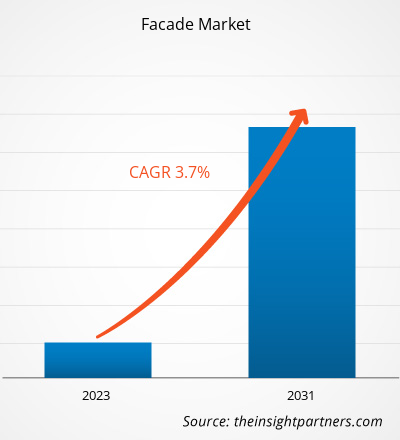Si prevede che il mercato delle facciate raggiungerà i 275,24 miliardi di dollari entro il 2031, rispetto ai 205,60 miliardi di dollari del 2023. Si prevede che il mercato registrerà un CAGR del 3,7% tra il 2023 e il 2031. È probabile che il settore edile in crescita in tutto il mondo rimanga una tendenza chiave nel mercato delle facciate.
Analisi del mercato delle facciate
La progettazione di edifici intelligenti nel settore edile è strettamente legata alla sostenibilità. L'applicazione di elementi intelligenti alle facciate future include la selezione e il test di diverse tecnologie per migliorare la qualità e le capacità di un sistema di facciata. Inoltre, vengono integrate tecnologie avanzate per migliorare le facciate aggiungendo valore e funzionalità agli edifici. Una facciata può essere definita intelligente quando è in grado di adattarsi alle condizioni ambientali e di trasformarsi di conseguenza, in base alla capacità di regolazione e adattabilità dei componenti a diverse condizioni, sia all'interno che all'esterno dell'edificio. Le facciate intelligenti includono anche vetri intelligenti per massimizzare la luce solare, proteggendo al contempo dalle radiazioni solari e controllando contemporaneamente la ventilazione e il riscaldamento quando necessario.
Panoramica del mercato delle facciate
La crescita del settore edile, supportata da agevolazioni governative e dalla crescente propensione alla costruzione di edifici ecosostenibili, sta influenzando i progetti infrastrutturali, trainando la crescita del mercato delle facciate. Inoltre, la penetrazione di materiali isolanti avanzati, come il cloruro di polivinile non plastificato (UPVC) e le facciate a doppia pelle, è maggiore rispetto ad altri materiali, in quanto migliorano l'efficienza energetica di un edificio. Inoltre, con l'avvento di tecnologie sofisticate come i pannelli prefabbricati per facciate, si prevede che il settore edile registrerà una crescita nei prossimi anni.
In base al materiale, il mercato globale delle facciate è segmentato in vetro, metallo, ceramica, legno e altri. Il segmento del metallo è ulteriormente suddiviso in alluminio, rame, acciaio e altri. Il segmento del metallo deteneva la quota di mercato maggiore nel 2023, grazie alla crescente adozione in applicazioni commerciali. Per applicazione, il mercato è segmentato in residenziale, commerciale e industriale. Il segmento commerciale ha dominato la quota di mercato nel 2023, in quanto la facciata è un sistema tradizionale utilizzato nell'edilizia per migliorare l'estetica.
Personalizza questo rapporto in base alle tue esigenze
Potrai personalizzare gratuitamente qualsiasi rapporto, comprese parti di questo rapporto, o analisi a livello di paese, pacchetto dati Excel, oltre a usufruire di grandi offerte e sconti per start-up e università
Mercato della facciata: Approfondimenti strategici

- Ottieni le principali tendenze chiave del mercato di questo rapporto.Questo campione GRATUITO includerà l'analisi dei dati, che vanno dalle tendenze di mercato alle stime e alle previsioni.
Potrai personalizzare gratuitamente qualsiasi rapporto, comprese parti di questo rapporto, o analisi a livello di paese, pacchetto dati Excel, oltre a usufruire di grandi offerte e sconti per start-up e università
Mercato della facciata: Approfondimenti strategici

- Ottieni le principali tendenze chiave del mercato di questo rapporto.Questo campione GRATUITO includerà l'analisi dei dati, che vanno dalle tendenze di mercato alle stime e alle previsioni.
Fattori e opportunità del mercato delle facciate
I vantaggi ambientali ed energetici delle facciate stimolano la crescita del mercato
Un sistema di facciata è una delle parti più importanti del design complessivo di una struttura, conferendole caratteristiche uniche. La facciata protegge l'edificio dai danni causati da venti forti e forti piogge, oltre a schermare la struttura da temperature e livelli di umidità estremi. Protegge inoltre dalla penetrazione della luce solare ultravioletta e offre una ventilazione naturale. I componenti di un sistema di facciata, come tetti, pareti, porte e finestre, controllano l'afflusso e il deflusso dell'aria e svolgono un ruolo chiave nel ridurre l'ingresso di polvere e altre particelle sospese nell'aria all'interno dell'edificio. Grazie al collegamento intelligente tra esterni e interni dell'edificio, la facciata contribuisce a controllare la penetrazione o la filtrazione della luce, la regolazione del calore e la minimizzazione dell'apporto solare, dando vita a edifici efficienti dal punto di vista energetico con livelli più elevati di schermatura solare e raffrescamento passivo.
Secondo il Programma delle Nazioni Unite per l'Ambiente, ogni anno gli edifici e la loro costruzione consumano oltre il 36% dell'energia globale e causano circa il 40% delle emissioni globali di gas serra. Diversi attori chiave stanno integrando facciate funzionali, tra cui facciate continue, che hanno un impatto positivo sull'efficienza energetica e offrono un'elevata resistenza agli agenti atmosferici, al calore, al rumore, alla luce e all'abbagliamento. Queste proprietà intrinseche delle facciate moderne e le crescenti preoccupazioni ambientali ed energetiche in tutto il mondo sostengono la crescita del mercato globale delle facciate.
Crescenti investimenti in progetti di sviluppo infrastrutturale
I crescenti investimenti per i progetti di sviluppo infrastrutturale in tutto il mondo stimolano la crescita del mercato: ad esempio, nel gennaio 2024, l'Agenzia esecutiva europea per il clima, l'ambiente e le infrastrutture ha ricevuto ∼ 400 domande richiedono 20 miliardi di dollari per progetti di infrastrutture di trasporto. La Cina è caratterizzata da uno dei più alti tassi di urbanizzazione al mondo. Secondo i dati dell'American Institute of Architects (AIA) di Shanghai, si prevede che la Cina avrà costruito l'equivalente di 10 città delle dimensioni di New York entro il 2025. Secondo l'International Trade Administration (ITA), il 14° Piano Quinquennale cinese enfatizza nuovi progetti infrastrutturali nei settori dell'energia, dei trasporti, dei sistemi idrici e della nuova urbanizzazione.
La progettazione di facciate intelligenti le rende più interattive e flessibili. L'ampia e versatile natura dell'adattabilità e delle innovazioni nella progettazione di facciate interattive creerebbe un ambito di crescita sempre maggiore per il mercato delle facciate nel prossimo futuro. Inoltre, vengono investiti ingenti investimenti in ricerca e capitali nello sviluppo di sistemi di facciata avanzati, con particolare attenzione ai sistemi di vetrate e alle varie tipologie di pareti.
Analisi della segmentazione del rapporto sul mercato delle facciate
I segmenti chiave che hanno contribuito all'analisi del mercato delle facciate sono il materiale, la tipologia di prodotto e l'applicazione.
- In base al materiale, il mercato globale delle facciate è segmentato in vetro, metallo, ceramica, legno e altri. Il mercato del segmento metallico è ulteriormente segmentato in alluminio, rame, acciaio e altri. Il segmento metallico ha detenuto la quota di mercato maggiore nel 2023, grazie alla crescente adozione in applicazioni commerciali.
- In base alla tipologia di prodotto, il mercato delle facciate è segmentato in finestre, porte, facciate continue e altri. Il settore delle costruzioni in tutto il mondo sta assistendo a una crescita significativa. Con la costruzione di edifici alti e solette più grandi, gli utenti finali sono alla ricerca di sistemi di casseforme avanzati che siano leggeri, riutilizzabili, convenienti, durevoli, flessibili e facili da montare e smontare.
- Per applicazione, il mercato è segmentato in residenziale, commerciale e industriale. Il segmento commerciale ha dominato la quota di mercato nel 2023, in quanto la facciata è un sistema tradizionale utilizzato in edilizia per migliorare l'estetica.
Analisi della quota di mercato delle facciate per area geografica
L'ambito geografico del rapporto sul mercato delle facciate è suddiviso principalmente in cinque regioni: Nord America, Asia-Pacifico, Europa, Medio Oriente e Africa e America meridionale e centrale.
Nel 2023, l'Asia-Pacifico ha detenuto la maggiore quota di fatturato del mercato globale delle facciate. Si stima che la regione registrerà un tasso di crescita moderato nel mercato globale delle facciate durante il periodo di previsione a causa di fattori quali la crescente urbanizzazione e industrializzazione. La numerosa popolazione nella regione ha generato un'elevata domanda di edilizia commerciale e residenziale. Inoltre, le attività di costruzione stanno crescendo in modo significativo nel Sud-est asiatico, il che dovrebbe sostenere la crescita del mercato delle facciate nella regione.
Approfondimenti regionali sul mercato delle facciate
Le tendenze regionali e i fattori che influenzano il mercato delle facciate durante il periodo di previsione sono stati ampiamente spiegati dagli analisti di The Insight Partners. Questa sezione illustra anche i segmenti e la geografia del mercato delle facciate in Nord America, Europa, Asia-Pacifico, Medio Oriente e Africa, America Meridionale e Centrale.
Ambito del rapporto sul mercato delle facciate
| Attributo del rapporto | Dettagli |
|---|---|
| Dimensioni del mercato in 2023 | US$ 205.60 billion |
| Dimensioni del mercato per 2031 | US$ 275.24 billion |
| CAGR globale (2023 - 2031) | 3.7% |
| Dati storici | 2021-2022 |
| Periodo di previsione | 2023-2031 |
| Segmenti coperti |
By Tipo di materiale
|
| Regioni e paesi coperti | Nord America
|
| Leader di mercato e profili aziendali chiave |
|
Densità degli attori del mercato delle facciate: comprendere il suo impatto sulle dinamiche aziendali
Il mercato delle facciate è in rapida crescita, trainato dalla crescente domanda degli utenti finali dovuta a fattori quali l'evoluzione delle preferenze dei consumatori, i progressi tecnologici e una maggiore consapevolezza dei vantaggi del prodotto. Con l'aumento della domanda, le aziende stanno ampliando la propria offerta, innovando per soddisfare le esigenze dei consumatori e sfruttando le tendenze emergenti, alimentando ulteriormente la crescita del mercato.

- Ottieni il Mercato della facciata Panoramica dei principali attori chiave
Notizie e sviluppi recenti sul mercato delle facciate
Il mercato delle facciate viene valutato raccogliendo dati qualitativi e quantitativi a seguito di ricerche primarie e secondarie, che includono importanti pubblicazioni aziendali, dati di associazioni e database. Di seguito è riportato un elenco degli sviluppi nel mercato delle facciate:
- Saint-Gobain, leader mondiale nell'edilizia leggera e sostenibile, ha annunciato la sua partnership con "Build Ahead", una coalizione guidata da aziende fondata da Xynteo. Questa società di consulenza orientata allo scopo aiuta le più grandi organizzazioni mondiali a scoprire modi di crescere a favore delle persone e del pianeta. La partnership è stata presentata durante l'evento di punta della coalizione, "The Exchange", a Nuova Delhi il 15 febbraio 2024. (Sito web aziendale di Saint Gobain SA, febbraio 2024)
- Saint-Gobain Glass ha integrato ORAE nel suo portafoglio. La soluzione COOL-LITE XTREME ORAE offre prestazioni e sostenibilità, riducendo le emissioni di carbonio operative (raffreddamento, riscaldamento e illuminazione durante l'utilizzo di un edificio) e incorporate nelle facciate degli edifici. (Sito web aziendale Saint Gobain SA, 2022)
Copertura e risultati del rapporto sul mercato delle facciate
Copertura e risultati del rapporto sul mercato delle facciate
Dimensioni e previsioni del mercato delle facciate (2021-2031) Il rapporto fornisce un'analisi dettagliata del mercato che copre le seguenti aree:
- Dimensioni e previsioni del mercato delle facciate a livello globale, regionale e nazionale per tutti i segmenti di mercato chiave coperti dall'ambito
- Tendenze del mercato delle facciate e dinamiche di mercato come fattori trainanti, vincoli e opportunità chiave
- Analisi PEST dettagliata e analisi SWOT
- Analisi del mercato delle facciate che copre le principali tendenze del mercato, il quadro globale e regionale, i principali attori, le normative e i recenti sviluppi del mercato
- Analisi del panorama industriale e della concorrenza che copre la concentrazione del mercato, l'analisi della mappa termica, i principali attori e i recenti sviluppi per il mercato delle facciate
- Profili aziendali dettagliati
- Analisi storica (2 anni), anno base, previsione (7 anni) con CAGR
- Analisi PEST e SWOT
- Valore/volume delle dimensioni del mercato - Globale, Regionale, Nazionale
- Industria e panorama competitivo
- Set di dati Excel
Report recenti
Testimonianze
Motivo dell'acquisto
- Processo decisionale informato
- Comprensione delle dinamiche di mercato
- Analisi competitiva
- Analisi dei clienti
- Previsioni di mercato
- Mitigazione del rischio
- Pianificazione strategica
- Giustificazione degli investimenti
- Identificazione dei mercati emergenti
- Miglioramento delle strategie di marketing
- Aumento dell'efficienza operativa
- Allineamento alle tendenze normative




















 Ottieni un campione gratuito per - Mercato della facciata
Ottieni un campione gratuito per - Mercato della facciata